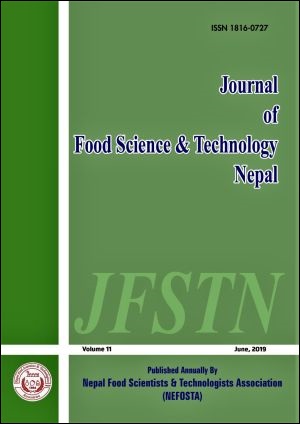Identifying the Diversity of Dominant LABs from Fermented Dairy Products Dahi and Yoghurt in Eastern Region of Nepal
DOI:
https://doi.org/10.3126/jfstn.v11i0.29699Keywords:
Antibiotic sensiivity, LAB, Isolation, dahl, yoghurt, fermented dairy productAbstract
The aim of this study was to isolate and identify lactic acid bacteria diversity from dahi/ yoghurt. Curd, also known as commercially prepared yoghurt or homemade Dahi, is formed during the slow lactic fermentation of lactose from milk by thermophilic lactic acid bacteria (LAB). Thirty-five samples of yoghurt and curd were collected from the Biratnagar and isolation and identification of bacteria were done by various microbiological techniques like MRS Agar inoculation, colony characteristics, microscopic and biochemical examination. A total of sixty-six strains of lactobacilli were isolated from curd and identification of strains was done by biochemical and carbohydrate utilization test. Lactobacillus bulgaricus, L. casei, L. fermentum, L. acidophilus, and Streptococcus thermophilus were identified from curd. pH of samples was between 3.0 to 4.0 for homemade dahi; while 4.34 to 4.5 for commercially available yoghurt. The mean colony count of lactic acid bacteria was 1.4x107–4.9x107 cfu/g. 37.9% of samples contained Streptococcus thermophilus, 30.3% had Lactobacillus bulgaricus. Forty-five isolates from 24 industrial yoghurt samples showed 37.5% of the yoghurt contained both Lactobacillus bulgaricus and Streptococcus thermophilus followed by 25% samples having S. thermophilus and L. acidophilus. Other species like L. fermentum and L. casei were less common. From 11 homemade dahi samples, 54.5% of curd possessed both S. thermophilus and L. bulgaricus; 18.2% curd had both S. thermophilus and L. fermentum. The study concludes that L. bulgaricus and Streptococcus thermophilus are prevalent potent lactic acid bacteria. This study provides an account of the diversity of lactic acid bacteria in dahi/ yoghurt which will provide useful information about the variable nature of curd in this region to future researchers.
Downloads
Downloads
Published
How to Cite
Issue
Section
License
The author will be the copyright holder of this open access journal - 'Journal of Food Science and Technology Nepal (JFSTN)'.




